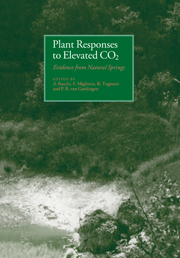Book contents
- Frontmatter
- Contents
- List of contributors
- Preface
- Sites of naturally elevated carbon dioxide
- Migration in the ground of CO2 and other volatile contaminants. Theory and survey
- Levels of CO2 leakage in relation to geology
- CO2 emission in volcanic areas: case histories and hazards
- Controlled degassing of lakes with high CO2 content in Cameroon: an opportunity for ecosystem CO2-enrichment experiments
- Burning coal seams in southern Utah: a natural system for studies of plant responses to elevated CO2
- Long-term effects of enhanced CO2 concentrations on leaf gas exchange: research opportunities using CO2 springs
- Using Icelandic CO2 springs to understand the long-term effects of elevated atmospheric CO2
- Plant CO2 responses in the long term: plants from CO2 springs in Florida and tombs in Egypt
- Acidophilic grass communities of CO2 springs in central Italy: composition, structure and ecology
- Studying morpho-physiological responses of Scirpus lacustris from naturally CO2-enriched environments
- Carbon physiology of Quercus pubescens Wild, growing at the Bossoleto CO2 spring in central Italy
- Preliminary results on dissolved inorganic 13C and 14C content of a CO2-rich mineral spring of Catalonia (NE Spain) and of plants growing in its surroundings
- The impact of elevated CO2 on the growth of Agrostis canina and Plantago major adapted to contrasting CO2 concentrations
- Stomatal numbers in holm oak (Quercus ilex L.) leaves grown in naturally and artificially CO2-enriched environments
- Effects of CO2 on NH4+ assimilation by Cyanidium caldarium, an acidophilic hot springs and hot soils unicellular alga
- Can rising CO2 alleviate oxidative risk for the plant cell? Testing the hypothesis under natural CO2 enrichment
- Increasing concentrations of atmospheric CO2 and decomposition processes in forest ecosystems
- Index
Migration in the ground of CO2 and other volatile contaminants. Theory and survey
Published online by Cambridge University Press: 10 February 2010
- Frontmatter
- Contents
- List of contributors
- Preface
- Sites of naturally elevated carbon dioxide
- Migration in the ground of CO2 and other volatile contaminants. Theory and survey
- Levels of CO2 leakage in relation to geology
- CO2 emission in volcanic areas: case histories and hazards
- Controlled degassing of lakes with high CO2 content in Cameroon: an opportunity for ecosystem CO2-enrichment experiments
- Burning coal seams in southern Utah: a natural system for studies of plant responses to elevated CO2
- Long-term effects of enhanced CO2 concentrations on leaf gas exchange: research opportunities using CO2 springs
- Using Icelandic CO2 springs to understand the long-term effects of elevated atmospheric CO2
- Plant CO2 responses in the long term: plants from CO2 springs in Florida and tombs in Egypt
- Acidophilic grass communities of CO2 springs in central Italy: composition, structure and ecology
- Studying morpho-physiological responses of Scirpus lacustris from naturally CO2-enriched environments
- Carbon physiology of Quercus pubescens Wild, growing at the Bossoleto CO2 spring in central Italy
- Preliminary results on dissolved inorganic 13C and 14C content of a CO2-rich mineral spring of Catalonia (NE Spain) and of plants growing in its surroundings
- The impact of elevated CO2 on the growth of Agrostis canina and Plantago major adapted to contrasting CO2 concentrations
- Stomatal numbers in holm oak (Quercus ilex L.) leaves grown in naturally and artificially CO2-enriched environments
- Effects of CO2 on NH4+ assimilation by Cyanidium caldarium, an acidophilic hot springs and hot soils unicellular alga
- Can rising CO2 alleviate oxidative risk for the plant cell? Testing the hypothesis under natural CO2 enrichment
- Increasing concentrations of atmospheric CO2 and decomposition processes in forest ecosystems
- Index
Summary
SUMMARY
Carbon dioxide is the main geosphere product affecting the biosphere. Its migration in the ground has several geological constraints whose understanding is essential for the study of its occurrence and behaviour in shallow environments, such as soil and groundwater. In industrialized, urban and rural areas high CO2 concentrations in the ground may be associated with volatile organic compounds whose effects on the biosphere may be remarkable. In these cases any environmental monitoring should consider all the contaminants, both endogenetic and anthropogenetic, occurring in the ground. This paper is an overview of the main geological factors controlling the migration of endogenetic gas to the surface and, in particular, the CO2 occurrence in soil and groundwater. Some guidelines are given for identifying and monitoring leakages of CO2 and other volatile contaminants based upon soil-gas, exhalation and groundwater surveys.
INTRODUCTION
The occurrence of high concentrations of volatile compounds at the Earth's surface, viz. in soil and groundwater, is the object of a wide series of researches and practical applications within the framework of environmental studies, exploration geology and earthquake prediction. In the first case the researches are particularly focused to those gases, both endogenetic and anthropogenetic, which may have toxic relevance or excite modifications in the biosphere (e.g., CO2, VOCs, CH4, CFCs, SO2, H2S, COS, CS2, HC1, HF, Rn). In the second and third case importance is given to those natural volatiles which may be used as “tracers” or “pathfinders” of subsurface energy sources (geothermal reservoirs, hydrocarbon or ore deposits), and which are sensitive to seismic stresses, respectively (e.g., He, Rn, CO2, H2, CH4, Ar, S-compounds).
- Type
- Chapter
- Information
- Plant Responses to Elevated CO2Evidence from Natural Springs, pp. 7 - 20Publisher: Cambridge University PressPrint publication year: 1997
- 4
- Cited by



